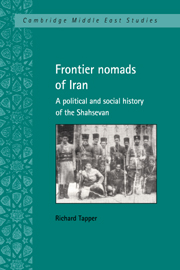Book contents
- Frontmatter
- Contents
- List of illustrations
- Preface
- Acknowledgments
- Note on transliteration
- Glossary
- 1 Writing tribal history
- PART I The Safavid state and the origins of the Shahsevan
- PART II The rise of the Shahsevan confederacy
- PART III The Shahsevan tribes in the Great Game
- 8 The Russian wars and the loss of Moghan
- 9 The Shahsevan nomads in the mid-nineteenth century
- 10 Nomads and commissars in Moghan
- PART IV The end of the tribal confederacy
- Appendices
- Bibliography
- Index of topics
- Index of places, peoples, persons, dynasties, parties, companies
- Index of authors quoted or discussed
- Index of tribal names
- Plate section
9 - The Shahsevan nomads in the mid-nineteenth century
Published online by Cambridge University Press: 05 March 2012
- Frontmatter
- Contents
- List of illustrations
- Preface
- Acknowledgments
- Note on transliteration
- Glossary
- 1 Writing tribal history
- PART I The Safavid state and the origins of the Shahsevan
- PART II The rise of the Shahsevan confederacy
- PART III The Shahsevan tribes in the Great Game
- 8 The Russian wars and the loss of Moghan
- 9 The Shahsevan nomads in the mid-nineteenth century
- 10 Nomads and commissars in Moghan
- PART IV The end of the tribal confederacy
- Appendices
- Bibliography
- Index of topics
- Index of places, peoples, persons, dynasties, parties, companies
- Index of authors quoted or discussed
- Index of tribal names
- Plate section
Summary
Economic conditions in the region
There has been a lively debate on the nature of the Iranian economy in the nineteenth century, focusing on the importance of such factors as population increase, urbanization, famine and drought, changes in production, and patterns of trade. In 1953, Lambton wrote that ‘the picture of the land revenue system and administration of the early Qajars is one of decay, maladministration, oppression and insecurity’, but the more recent consensus is expressed by Hambly: ‘Fath 'Ali Shah's reign ultimately afforded sufficient order and effective government to make possible some economic recovery … Fath 'Ali Shah's Iran was more tranquil and prosperous than it had been at any time since Safavid rule had ceased to be effective.’
Azarbaijan continued to be, politically at least, the most important province of Iran. It was the chief recruiting ground for the Qajar armies, if not also the chief supplier of agricultural produce, and Tabriz, with around 200,000 inhabitants, was the largest and most important city of the country and usually the seat of the heir apparent, as well as the main emporium of the rapidly expanding trade with Russia and the West. Russia was naturally the paramount foreign influence in the political and economic affairs of the province, though the British often managed to exert some pressure through their consular officials in Tabriz.
- Type
- Chapter
- Information
- Frontier Nomads of IranA Political and Social History of the Shahsevan, pp. 169 - 189Publisher: Cambridge University PressPrint publication year: 1997



